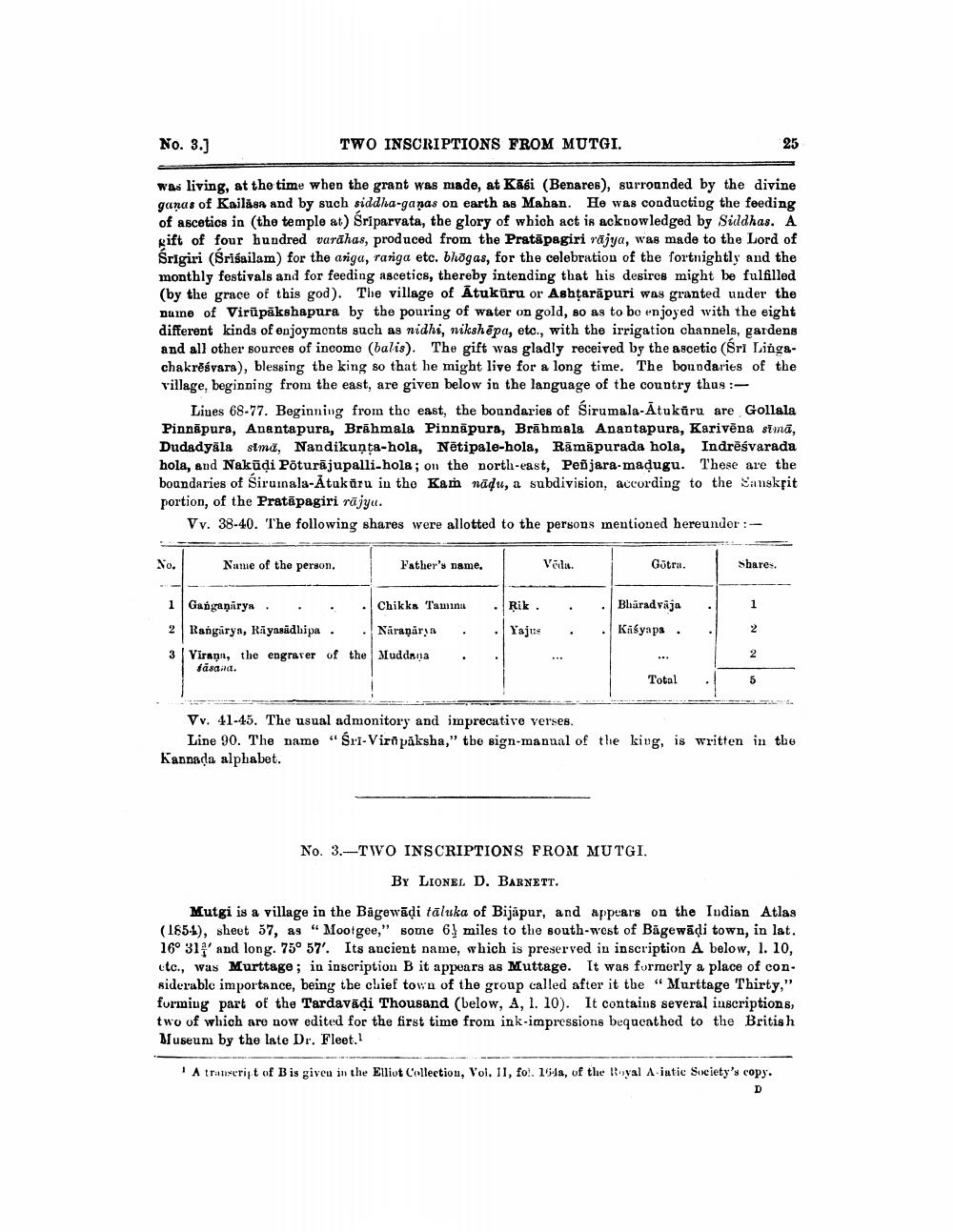________________
No. 3.]
TWO INSCRIPTIONS FROM MUTGI.
25
was living, at the time when the grant was made, at Kābi (Benares), surrounded by the divine ganas of Kailasa and by such siddha-ganas on earth as Mahan. He was conducting the feeding of ascetios in the temple at) Sriparvata, the glory of which act is acknowledged by Siddhas. A gift of four hundred varāhas, produced from the Pratāpagiri rājya, was made to the Lord of Srigiri (Srisailam) for the anga, ranga etc. bhogas, for the celebration of the fortnightly and the monthly festivals and for feeding ascetics, thereby intending that his desires might be fulfilled (by the grace of this god). The village of Ātukūru or Ashtarāpuri was granted under the nunne of Virūpākshapura by the pouring of water on gold, so as to be enjoyed with the eight different kinds of enjoyments such as nidhi, nikshēpa, etc., with the irrigation channels, gardens and all other sources of income (balis). The gift was gladly received by the ascetic (Sri Lingachakrēsvara), blessing the king so that he might live for a long time. The boundaries of the village, beginning from the east, are given below in the language of the country thus:
Lines 68-77. Beginning from the east, the boundaries of Sirumala-Ātukūru are Gollala Pinnāpura, Anantapura, Brāhmala Pinnapura, Brāhmala Anantapura, Karivēna sīmā, Dudadyāla sima, Nandikunta-hola, Nētipale-hola, Rāmāpurada hola, Indreśvarada hola, and Nakūļi Põturājupalli-hola; on the north-east, Peñjara-madugu. These are the boundaries of Sirunala-Ātukūru in the Kam nādu, a subdivision, according to the Sanskrit portion, of the Pratāpagiri rājyu.
Vv. 38-40. The following shares were allotted to the persons mentioned hereunder :
No.
Name of the person.
Father's name,
Veda.
Götra.
Shares.
1 Ganganirya. . . . Chikka Tamina 2 Rangārya, Rāyasādhipa . .Niraņāra 3 Viraņı, the engraver of the Muddana
fasadi.
. Rik .
Yajus
. .
. Bhäradvaja . Kiśyapa.
Total
Vv. 41-45. The usual admonitory and imprecative verses.
Line 90. The name “Sri-Virü páksha," tbe sign-manual of the king, is written in the Kannada alphabet.
No. 3.--TWO INSCRIPTIONS FROM MUTGI.
BY LIONEL D. BARNETT.
Mutgi is a village in the Bagewādi tāluka of Bijāpur, and appears on the Indian Atlas (1854), sheet 57, as "Mootgee," some 6 miles to the south-west of Bāgewādi town, in lat. 16° 31and long. 75° 57'. Its ancient name, which is preserved in inscription A below, 1. 10, etc., was Murttage; in inscription B it appears as Muttage. It was formerly a place of con. siderable importance, being the chief town of the group called after it the "Murttage Thirty," forming part of the Tardavādi Thousand (below, A, 1. 10). It contains several inscriptions, two of which are now edited for the first time from ink-impressions bequeathed to the British Museum by the late Dr. Fleet.
A transcript of B is given in the Elliot Collection, Vol. II, fol. 1648, of the Royal Aiatic Society's copy.




